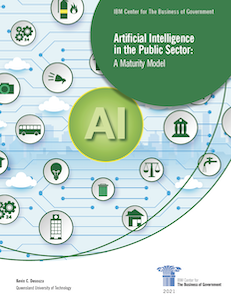
Artificial Intelligence in the Public Sector

The pace of these changes is so rapid that it has become necessary to harness the power of emerging technology as a key enabler of addressing these threats to our way of life. In particular, artificial intelligence (AI) has emerged as a force for public good in recent years. The technology is revolutionizing the way we derive value and insights from data in order to improve our daily lives. In addition, governments gather a treasure trove of pertinent data that can be used to execute important missions and improve services to the citizen. An effective AI program can greatly enhance the ability of the public sector to deliver on that promise.
Government agencies in the U.S. and around the world are increasingly investing in AI initiatives. Advances in AI enable agencies to:
- increase efficiency of operations via automation,
- innovate by empowering the public workforce with augmented intelligence for decision making, and
- improve access to and quality of service delivery.
The challenge has always been to design and implement an AI program that has all the critical elements in place to successfully achieve the goal of improved mission delivery and citizen services. An initial report commissioned by the IBM Center for The Business of Government, Delivering Artificial Intelligence in Government: Challenges and Opportunities, proposed an initial maturity model that gave public agencies a starting point for developing an AI capability. Subsequently, we have had the opportunity to fine tune the model, based on extensive research on how the public sector was deploying AI, documenting successful use cases and highlighting pitfalls and lessons learned. The revised maturity model was shared with experienced public sector practitioners and feedback from these discussions led to a further revision. The revised model was then shared with a final group of reviewers that included public sector executives (both within and beyond the information systems domain), academics, and consultants.
On behalf of the IBM Center for The Business of Government, we are pleased to publish this new report, Artificial Intelligence in the Public Sector: A Maturity Model, by Kevin Desouza Professor of Business, Technology and Strategy at Queensland University of Technology. This report outlines an AI maturity model based on practical experience and research insights with the goal of providing guidance and supporting evaluation and facilitating the success of AI projects in the public sector. To achieve success with AI, Mr. Desouza indicates that agencies must show proficiency on six core elements:
- Big data - Agencies must make sense of large data reservoirs through the application of machine learning algorithms. Public agencies should be able to access, integrate, and leverage data of interest in an effective and efficient manner.
- AI systems - Computational systems are the engines that transform data into actionable insights and outcomes. AI applications leverage a range of computational techniques to ingest, analyze, visualize, and even act on data.
- Analytical capacity - AI systems must be supported by human analytical capacity and need a well-trained workforce that is analytically aware and has the aptitude to leverage data to derive value and insights.
- Innovation climate - Public agencies need to innovate if they are to deliver on their objectives given the ever-evolving missions. Agencies must overcome a risk averse posture and create a climate of innovation where experimentation is encouraged.
- Governance and ethical frameworks – Governance must be established to assign responsibility and accountability for outcomes resulting from an AI program. Care must be given to appropriate data use and ethical frameworks.
- Strategic visioning – AI programs should be incorporated into strategic visioning and strategic planning exercises from the outset and should be supported by senior leadership.
Each one of these elements is necessary to run a successful AI program. The elements are interdependent and not mutually exclusive. In addition, the development of each element should be appropriately sequenced in relation to all the other elements. Mr. DeSouza also indicates that the “maturity model charts the progressive development of AI competencies from ad hoc to experimentation, planning and deployment, scaling and learning, and finally, enterprise-wide transformation.”
We hope that this report provides public sector leaders a view into the “art of the possible” by emphasizing how AI programs can accelerate the transformation of government programs to better serve the public and by providing them a framework for establishing a successful AI program. The report provides many examples and proof points that illustrate each of the concepts resident in the AI maturity model. We will continue to explore this topic and will provide further updates as the use of AI in the public sector continues to evolve.



